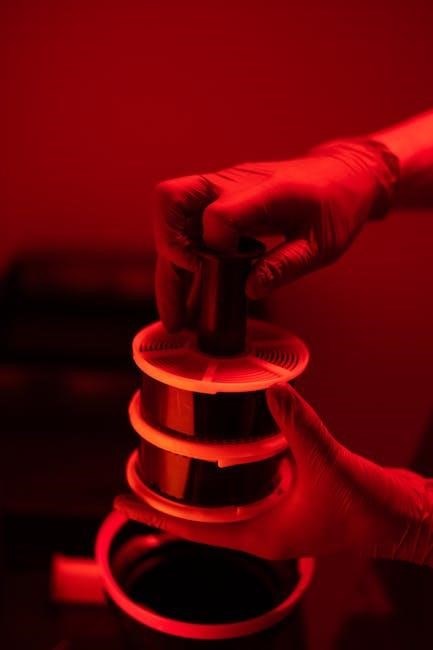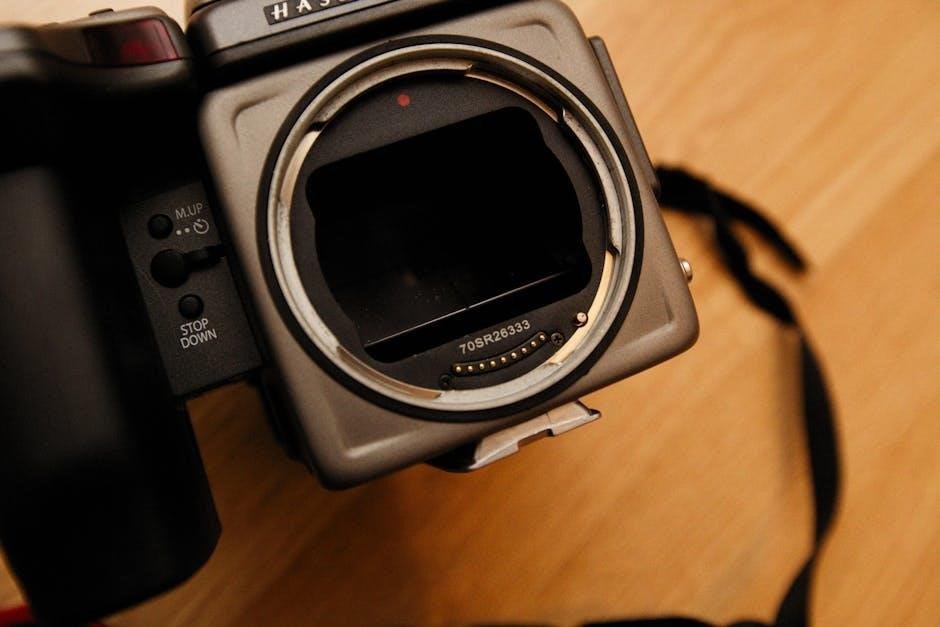Motion sensor light switches with manual override combine automation and user control, offering convenience and energy efficiency. They detect movement to turn lights on/off automatically but also allow manual operation for flexibility.
1.1 Definition and Purpose
A motion sensor light switch with manual override is a device that automatically controls lighting based on movement detection while allowing manual operation. It combines the convenience of automation with the flexibility of traditional switching, ensuring energy efficiency and user control. This dual functionality makes it ideal for various applications, enhancing both comfort and security in residential and commercial spaces.
1.2 Importance of Manual Override in Motion Sensor Switches
The manual override feature in motion sensor switches provides essential flexibility, allowing users to control lighting independently of automation. This is crucial for scenarios where automatic detection fails, ensuring consistent light operation. It also offers a backup option during sensor malfunctions, preventing darkness and enhancing overall reliability and user satisfaction in both residential and commercial environments.

Key Features of Motion Sensor Light Switches
Motion sensor light switches feature advanced detection technology, manual override functionality, and adjustable settings for sensitivity and timer control, ensuring customizable and efficient lighting solutions.
2.1 Motion Detection Technology
Motion detection technology in these switches uses sensors, often passive infrared (PIR), to detect heat and movement within a specific range. They automatically trigger lighting upon sensing motion, enhancing convenience and security. Advanced models offer adjustable sensitivity and coverage areas, ensuring reliable performance in various environments while minimizing false activations.
2.2 Manual Override Functionality
Manual override allows users to switch lights on/off independently of motion detection, ensuring flexibility in lighting control. This feature is especially useful when continuous lighting is needed, overriding the sensor’s automation. The override function typically operates via a physical switch, providing a reliable fallback option without disabling the sensor’s automatic operation when reverted.
2.3 Adjustable Settings (Sensitivity, Timer, etc.)
Adjustable settings like sensitivity and timer enable customization of motion sensor functionality. Sensitivity adjustments prevent false triggers, while timer settings control how long lights stay on after motion ceases. These features optimize performance for specific environments, ensuring energy efficiency and user convenience without compromising automation capabilities or manual override benefits.

Installation and Wiring Requirements
Installation requires understanding wiring diagrams and connecting live, neutral, and ground wires. Some models need a neutral wire for operation, while others may present wiring challenges without it.
3.1 Understanding the Wiring Diagram
Understanding the wiring diagram is crucial for correct installation. It typically shows connections for live, neutral, and ground wires. The diagram illustrates how the sensor and manual override integrate, ensuring proper power supply and switching functionality. This visual guide helps avoid common wiring errors and ensures the switch operates as intended for both motion sensing and manual control.
3.2 Connecting Live, Neutral, and Ground Wires
Connecting live, neutral, and ground wires ensures proper power supply and safe operation. The live wire provides power, the neutral completes the circuit, and the ground wire ensures safety. Proper connections prevent electrical hazards and allow manual override functionality to work seamlessly. Always follow the wiring diagram and local electrical codes.
3.3 Common Installation Challenges and Solutions
Common challenges include incorrect wiring, lack of neutral wires, and sensor placement issues. Ensure proper connections by following the wiring diagram. If no neutral wire is present, verify compatibility or consult a professional. Adjust sensor placement and sensitivity for optimal detection. Regularly check connections and settings to maintain reliable operation and avoid malfunctions.

Types of Motion Sensor Light Switches
Motion sensor light switches come in various types, including indoor, outdoor, and smart options. Each offers unique features like voice control and remote monitoring, enhancing functionality;
4.1 Indoor vs. Outdoor Motion Sensor Switches
Indoor motion sensor switches are designed for household use, offering features like adjustable sensitivity and timers, while outdoor switches are built to withstand weather and provide security lighting. Both types ensure energy efficiency and convenience, but outdoor models require durable construction and proper weatherproofing to function effectively in harsh environments.
4.2 Smart Motion Sensor Switches with Voice Control
Smart motion sensor switches with voice control integrate seamlessly with smart home systems like Amazon Alexa or Google Assistant, enabling hands-free operation. Users can control lighting remotely via mobile apps or voice commands, enhancing convenience and modernizing home automation. These switches combine motion detection with smart features for a tailored lighting experience, offering flexibility and advanced functionality.
Benefits of Using Motion Sensor Light Switches
Motion sensor light switches offer energy efficiency and cost savings by reducing unnecessary lighting usage. They provide enhanced convenience and security, automatically illuminating spaces and deterring intruders with timely activation.
5.1 Energy Efficiency and Cost Savings
Motion sensor light switches enhance energy efficiency by automatically turning lights off when no motion is detected, reducing unnecessary usage. They also extend bulb life and lower electricity bills. The manual override feature allows users to switch lights off when automation isn’t needed, further optimizing energy savings and reducing operational costs over time.
5.2 Enhanced Convenience and Security
Motion sensor light switches offer hands-free operation, eliminating the need to physically toggle lights, which is especially convenient in high-traffic areas. They also boost security by automatically illuminating spaces, deterring intruders, and providing unexpected lighting changes. The manual override adds flexibility, ensuring users can control lighting manually when automation isn’t desired, enhancing both convenience and peace of mind.

Troubleshooting Common Issues
Motion sensor light switches may face issues like faulty detection or override malfunction. Ensure proper wiring, adjust sensitivity settings, and clean sensors for optimal performance. Regular checks prevent unexpected failures, ensuring reliable operation and user satisfaction.
6.1 Motion Sensor Not Detecting Movement
If the motion sensor isn’t detecting movement, check for wiring issues or loose connections. Ensure the sensor is clean and unobstructed. Adjust sensitivity settings or test the sensor in a different location. Verify power supply and check for interference from other devices. Regular maintenance and proper installation are key to resolving detection problems effectively.
6.2 Manual Override Not Functioning Properly
If the manual override isn’t working, check for loose connections or wiring issues. Ensure the switch is properly installed and powered. Verify that the override function is calibrated correctly and free from interference. Consult the user manual or contact a professional if the problem persists. Regular maintenance can prevent such issues, ensuring reliable operation of the switch.

Smart Home Integration
Motion sensor light switches integrate seamlessly with smart home systems, enabling voice control through Amazon Alexa or Google Assistant. They offer remote access via mobile apps, enhancing convenience and security. Compatibility with smart systems allows for advanced automation, making these switches a versatile choice for modern homes.
7.1 Compatibility with Smart Home Systems
Motion sensor light switches are compatible with popular smart home systems like Amazon Alexa and Google Assistant. They integrate seamlessly, allowing voice control and remote access via mobile apps. This compatibility enhances convenience, enabling users to manage lighting without physical interaction, while ensuring security and energy efficiency through smart automation features.

7.2 Remote Control via Mobile Apps
Motion sensor light switches with manual override can often be controlled remotely through dedicated mobile apps. These apps allow users to schedule lighting, adjust settings, and receive notifications. Remote control enhances convenience, enabling users to manage their lighting systems from anywhere, while also improving security by allowing lights to be activated even when no one is present.

Safety and Compliance
Motion sensor light switches must adhere to electrical safety standards to prevent hazards. Proper grounding, compliance with building codes, and certification ensure reliable operation and user protection always.
8.1 Electrical Safety Standards
Motion sensor light switches must meet strict electrical safety standards to ensure safe operation. Proper grounding, secure connections, and compliance with certifications like UL (Underwriters Laboratories) are essential. These standards prevent electrical hazards, such as shocks or fires, by ensuring devices are tested for reliability and durability under various conditions. Always follow local electrical codes for installation.
8.2 Building Code Requirements
Motion sensor light switches with manual override must comply with local building codes, ensuring safe and proper installation. Many jurisdictions require switches to include a neutral wire for operation and manual override functionality. Wiring must adhere to regional electrical codes, and installations should follow approved diagrams. Some areas mandate motion sensors for specific spaces, like bathrooms, to meet accessibility and energy standards.

Maintenance and Upkeep
Regularly clean the motion sensor to ensure accurate detection. Check and tighten wiring connections. For smart switches, update firmware periodically. Replace worn-out components as needed.
9.1 Cleaning the Motion Sensor
Cleaning the motion sensor is essential for optimal performance. Use a soft, dry cloth to wipe away dust and dirt. Avoid harsh chemicals or abrasive materials. Regular maintenance ensures accurate detection and reliable operation. For smart sensors, check for firmware updates to enhance functionality. Clean the lens gently to prevent scratches and maintain sensitivity.
9.2 Replacing or Upgrading Components
Replacing or upgrading components ensures optimal performance. Start by disconnecting power and removing the old part. Install the new component, ensuring compatibility with your system. Follow manufacturer instructions for proper installation. Upgrading sensors or switches can enhance functionality and reliability. Regular checks help identify worn-out parts, preventing sudden failures and maintaining seamless operation.
Motion sensor light switches with manual override offer a perfect blend of automation, energy efficiency, and user control, making them a practical choice for modern homes.
10.1 Final Thoughts on Motion Sensor Light Switches
Motion sensor light switches with manual override are a practical and efficient solution for modern lighting needs. They offer enhanced convenience, energy savings, and security, making them ideal for various applications. Their ability to adapt to different settings ensures versatility, while the manual override provides reliability in unexpected situations, solidifying their place as a smart home essential.
10.2 Future Trends in Motion Sensor Technology
Future trends in motion sensor technology include enhanced smart home integration, voice control via Alexa and Google Assistant, and energy-efficient designs. Advances in AI-driven systems will enable adaptive learning, improving automation. These innovations promise seamless functionality, making motion sensor switches indispensable in modern living spaces.